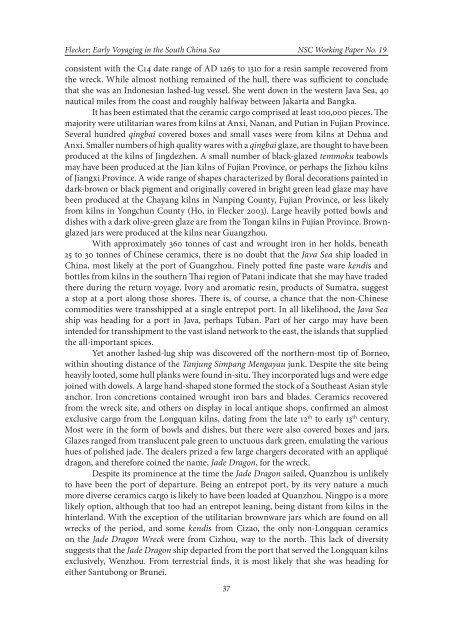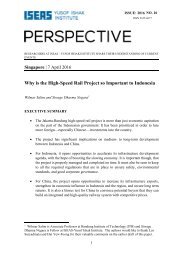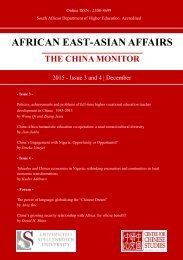NO.19
nscwps19_early_voyaging_south_china_sea_implications_territorial_claims
nscwps19_early_voyaging_south_china_sea_implications_territorial_claims
You also want an ePaper? Increase the reach of your titles
YUMPU automatically turns print PDFs into web optimized ePapers that Google loves.
Flecker: Early Voyaging in the South China Sea NSC Working Paper No. 19consistent with the C14 date range of AD 1265 to 1310 for a resin sample recovered fromthe wreck. While almost nothing remained of the hull, there was sufficient to concludethat she was an Indonesian lashed-lug vessel. She went down in the western Java Sea, 40nautical miles from the coast and roughly halfway between Jakarta and Bangka.It has been estimated that the ceramic cargo comprised at least 100,000 pieces. Themajority were utilitarian wares from kilns at Anxi, Nanan, and Putian in Fujian Province.Several hundred qingbai covered boxes and small vases were from kilns at Dehua andAnxi. Smaller numbers of high quality wares with a qingbai glaze, are thought to have beenproduced at the kilns of Jingdezhen. A small number of black-glazed temmoku teabowlsmay have been produced at the Jian kilns of Fujian Province, or perhaps the Jizhou kilnsof Jiangxi Province. A wide range of shapes characterized by floral decorations painted indark-brown or black pigment and originally covered in bright green lead glaze may havebeen produced at the Chayang kilns in Nanping County, Fujian Province, or less likelyfrom kilns in Yongchun County (Ho, in Flecker 2003). Large heavily potted bowls anddishes with a dark olive-green glaze are from the Tongan kilns in Fujian Province. Brownglazedjars were produced at the kilns near Guangzhou.With approximately 360 tonnes of cast and wrought iron in her holds, beneath25 to 30 tonnes of Chinese ceramics, there is no doubt that the Java Sea ship loaded inChina, most likely at the port of Guangzhou. Finely potted fine paste ware kendis andbottles from kilns in the southern Thai region of Patani indicate that she may have tradedthere during the return voyage. Ivory and aromatic resin, products of Sumatra, suggesta stop at a port along those shores. There is, of course, a chance that the non-Chinesecommodities were transshipped at a single entrepot port. In all likelihood, the Java Seaship was heading for a port in Java, perhaps Tuban. Part of her cargo may have beenintended for transshipment to the vast island network to the east, the islands that suppliedthe all-important spices.Yet another lashed-lug ship was discovered off the northern-most tip of Borneo,within shouting distance of the Tanjung Simpang Mengayau junk. Despite the site beingheavily looted, some hull planks were found in-situ. They incorporated lugs and were edgejoined with dowels. A large hand-shaped stone formed the stock of a Southeast Asian styleanchor. Iron concretions contained wrought iron bars and blades. Ceramics recoveredfrom the wreck site, and others on display in local antique shops, confirmed an almostexclusive cargo from the Longquan kilns, dating from the late 12 th to early 13 th century.Most were in the form of bowls and dishes, but there were also covered boxes and jars.Glazes ranged from translucent pale green to unctuous dark green, emulating the varioushues of polished jade. The dealers prized a few large chargers decorated with an appliquédragon, and therefore coined the name, Jade Dragon, for the wreck.Despite its prominence at the time the Jade Dragon sailed, Quanzhou is unlikelyto have been the port of departure. Being an entrepot port, by its very nature a muchmore diverse ceramics cargo is likely to have been loaded at Quanzhou. Ningpo is a morelikely option, although that too had an entrepot leaning, being distant from kilns in thehinterland. With the exception of the utilitarian brownware jars which are found on allwrecks of the period, and some kendis from Cizao, the only non-Longquan ceramicson the Jade Dragon Wreck were from Cizhou, way to the north. This lack of diversitysuggests that the Jade Dragon ship departed from the port that served the Longquan kilnsexclusively, Wenzhou. From terrestrial finds, it is most likely that she was heading foreither Santubong or Brunei.37








